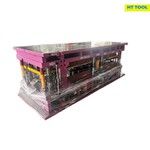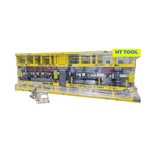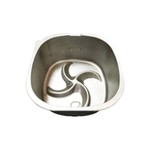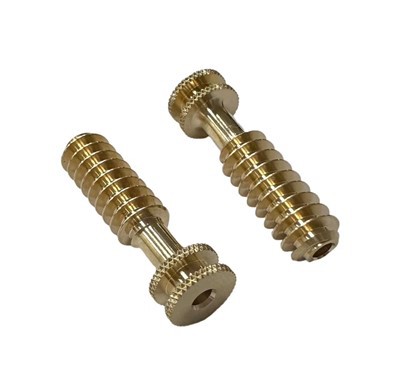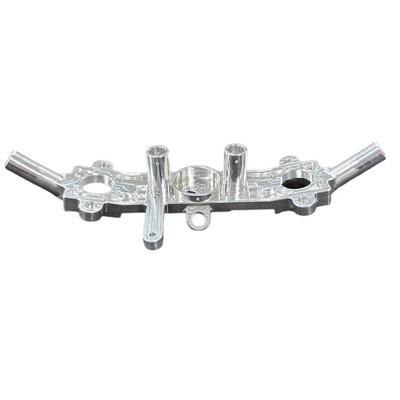Machined Parts
Company Profile
HT TOOL is highly experienced with Progressive Tooling from medium to high complex parts up to 1300mm width. Our costumers can expect to achieve the maximum productivity/quality from our progressive tools.
Why Choose Us
Rich Experience
Continuously providing our customers with diverse and highest quality die making services and delivering first-class metal stamping dies and parts with precision, accuracy, speed and efficiency.
One-stop Solution
HT TOOL is committed to providing reliable one-stop solutions for the tool and die industry, and through our strengths to become the preferred supplier within the metal stamping die industry.
Professional Team
In tooling design department, we are able to provide a comprehensive service to our customers. Our project managers (x2) are in permanent contact with our customers during the project development process and during the mass production of the dies.
Customized services
Our assembly units offer maximum flexibility to meet our customers' needs, adding value to each part with customer satisfaction in mind.

Machined parts are everywhere.Machined parts can be formed in different ways. The process of machining can be manual, whereby a machinist (a skilled professional operator of machining equipment) handles a machine like a mill to manually cut the workpiece into the desired shape.
Machined parts are components created through the process of machining, a broad term referring to a controlled material-removal process. Machining involves a range of techniques, such as milling, turning, drilling, and grinding, to shape a piece of raw material into a desired form or part. This could involve transforming a metal block into a complex gear or a plastic rod into a precise instrument component.
Benefits of Machined Parts
Good prototypes
Machined parts are suitable and affordable as prototypes because they can be fabricated as one-offs.
The material versatility of machining also means companies can, for example, order machined parts in several different metal alloys or composite plastics to see which performs best under test conditions.
Quality
Machined parts can be made to a very high standard. Perhaps more importantly, customers can specify tolerances which need to be met by the machinist. This means the machinist or machine operator can take extra time on tight tolerance machining parts and individual features.
While injection molds can also be made to tight tolerances, each individual molding cannot be held to such high standard.
Strength
Machined parts are cut from solid pieces of material known as blanks, which have typically been cast or extruded. This makes them very strong compared to, for example, 3D printed parts, which can be much weaker along one axis where one layer is built upon the next.
Surface finish
Machined parts avoid the surface quality issues associated with molding such as flow lines, jetting, and flash at the parting line. With a moderate amount of post-processing, machined parts can be brought to a very high standard in terms of surface finish.
Machined Parts Categorization of machining processes
In general, all machining processes can be divided into two distinct machining categories: conventional and non-conventional. The processes differ with regards to the tools used for removing excess material.
Conventional Machining
Conventional machining represents a mechanical process. Machinists use a sharp tool to cut away excess material from a part.
Non-Conventional Machining
Non-conventional machining processes encompass two sub-categories: chemical machining and thermal machining.
Chemical machining: This process involves using baths of temperature-regulated etching chemicals. The chemicals remove material from the part, thus creating a metal component of a specified shape. Chemical machining can be a regular or an electrochemical process.
Thermal machining: This process employs a source of thermal energy, such as a laser or an industrial torch, to direct intense heat towards a metal part in order to remove excess material. Types of thermal machining include torch cutting, electrical discharge machining and high energy beam machining.
How to Design Machined Parts?
It is always best to employ design for manufacturing (DfM) principles: design parts based on the manufacturing process that will be used. Parts for machining need to be designed differently to, for example, parts for 3D printing.
Undercuts
Undercuts are cuts in the workpiece that cannot be executed using standard cutting tools (because a section of the part is obstructing it). They require special cutting tools — T-shaped ones, for example — and special machining design considerations.
Since cutting tools are made in standard sizes, undercut dimensions should be in whole millimeters to match the tool. (For standard cuts this doesn’t matter, since the tool can move back and forth in tiny increments.)
Wall thickness
Contrary to molded parts, which deform if walls are too thick, machined parts cannot handle especially thin walls. Designers should avoid thin walls, or use a process like injection molding if thin walls are integral to the design.
Protrusions
As with thin walls, tall protruding sections are difficult to machine, as the vibrations of the cutting tool can damage the section or result in lower accuracy.
Cavities, holes, and threads
When designing machined parts, it is important to remember that holes and cavities are dependent on the cutting tools.
Cavities and pockets can be machined into a part to a depth of four times the cavity width. Deeper cavities will necessarily end up with fillets — rounded rather than sharp edges — because of the required cutting tool diameter.
Holes, which are made with drill bits, should also have a depth of no more than four times the drill bit width. And hole diameters should, where possible, correspond to standard drill bit sizes.
Scale
CNC machined parts are limited in size because they are fabricated within the build envelope of the machine. Milled parts should measure no more than 400 x 250 x 150 mm; turned parts should measure no more than Ø 500 mm x 1000 mm.
What Materials Are Used in machined parts?
Machined parts come in many different materials to suit many different purposes. The process is versatile and delivers excellent results with a wide range of metals and plastics.
Stainless Steel
Many of the applications that require machined parts also require the highest quality materials. Stainless steel is one example, both strong and corrosion-resistant. There are actually many distinct metal alloys within the category of stainless steel, each with its own unique uses for machined parts.
Brass
Brass is still one of the most widely used metals today due to its superior corrosion and wear resistance. It’s also very easy to machine, making machining very cost-effective for an incredibly wide range of brass parts.
Aluminum
Machined aluminum is seeing increased adoption across many industries. Incredibly lightweight, aluminum is replacing steel in many applications. However, it’s a challenging metal to work with, and companies must rely on precision machine shops to get the best results.
Plastics
While most people associate metal with machined parts, the technique works well with many types of plastic as well. It provides an effective subtractive manufacturing method compared to the additive method of 3D-printed parts.
Machined Part Surface Finishes
Various compatible post-processing operations help to enhance the surface texture and functionality of machined parts. Below are some of the standard machined parts’ surface finishes:
As-Machined
The machined finish option doesn’t involve applying surface treatment to the machined parts. It is the exact surface condition of the machined part as it exits the CNC machine. It is often perfect for many internal, non-cosmetic functional parts.
Powder Coated
Powder coating finish involves spraying powdered paint in any preferred color onto the machined part, after which it is oven-baked. It forms a solid coating on the machined part, improving its wear resistance. The coating is more durable than regular paint coatings.


Anodized
This electrochemical process improves aluminum machined parts’ corrosion resistance. It forms a scratch and corrosion-resistant layer on metal parts. The Type II anodization process provides a corrosion-resistant finish on aluminum machined parts. Conversely, the Type III anodization creates a thicker coating on machined parts for better wear and chemical resistance.
Bead Blasted
It involves firing abrasive media (tiny beads) at the surface of machined parts at high velocity. This process helps to remove sharp edges, burrs, and residual materials. However, you can modify this process to achieve a certain level of roughness. However, bead blasting may be incompatible with fine features since the procedure removes material and can affect the machined part’s geometry.
What are the Applications of Machined Parts?
Aerospace:
The aerospace sector depends on machined parts for airplane and spacecraft elements. Machining components frequently serve the purpose in engine parts, landing gear, control systems, and other aerospace applications where elevated precision and dependability are significant.
Medical Treatment:
Machined components hold a vital position in the medical domain. Machining parts are fundamental in producing surgical instruments, orthopedic implants, medical devices, and diagnostic apparatus.
Machining guarantees accurate measurements, polished surfaces, and biocompatibility for secure medical treatments.
Automotive:
Machining parts often find use in the automotive industry for engines, transmissions, and braking systems. Within the automotive field, the precision and robustness of machined parts boost vehicle performance and reliability.
Industrial Equipment:
Machined parts are fundamental to industrial equipment like manufacturing, energy, oil and gas, and construction.
These parts frequently find use in machinery, pumps, valves, turbines, and compressors. Machined parts offer accurate and dependable functionality in challenging industrial settings.
Consumer Goods:
Machined parts help in creating consumer goods, including electronics, appliances, furniture, and sporting equipment.
From tiny precision parts to ornamental or functional elements in consumer products, machining guarantees top-notch and accurate attributes.
How to Do Quality Control of Machined Components?
Securing the quality of machined components is vital to ensure their performance, dependability, and compliance with specifications. Here are some primary approaches for quality control of machined parts:
A comprehensive inspection is necessary to confirm machined components’ dimensional accuracy, surface quality, and functionality.
This may include a visual examination, measurement using precise tools like calipers or micrometers, and specialized inspection tools such as coordinate measuring machines (CMMs) or optical measurement systems.
Acquiring ISO certification, like ISO 9001, showcases a dedication to quality management systems and guarantees that particular quality control procedures and standards are observed while manufacturing machined components.
ISO certification offers assurance to customers and stakeholders about the quality and consistency of the produced parts.
Implementing traceability systems allows for the identification and tracking of machined components throughout manufacturing.
This includes recording relevant information such as raw material batch numbers, machine settings, operator details, and inspection results. Traceability ensures accountability and facilitates investigations of any quality issues or product recalls.
Testing machined components under relevant conditions and loads are crucial to validate their performance and durability. This can involve functional testing, stress testing, leak testing, or any other specific tests based on the component’s intended use.
Cleaning Machined Parts
Why Cleaning Machined Parts is Paramount
Machined parts excellence begins with cleanliness. Clean machined parts not only enhance performance but also extend the overall lifespan of the components. Accumulation of impurities and contaminants can adversely affect the precision and quality achieved through machined parts. Let's explore the profound impact that cleaning has on the performance and longevity of machined parts.
Importance of Cleanliness in machined parts
In the intricate world of machined parts, cleanliness is the cornerstone of precision. The tiniest particle can disrupt the delicate dance of machined parts processes, leading to defects, inaccuracies, and reduced component lifespan. Each machined parts operation demands an environment free from contaminants, ensuring that every cut and movement is executed with the utmost accuracy. Clean machined parts are not just a byproduct; they are the essence of superior machined parts.
Performance Enhancement Through Cleaning
Cleanliness is directly proportional to performance in machined parts. A meticulously cleaned machined part experiences reduced friction, contributing to smoother movements and prolonged equipment life. The absence of contaminants ensures that each cut is executed as intended, minimizing the risk of tool wear and tear. From the initial design phase to the final product, cleanliness is the silent force that elevates the precision and efficiency of machined parts.
Preventing Accumulation of Impurities and Contamination
In the realm of machined parts, preventing the accumulation of impurities and contamination is paramount. Neglecting proper cleaning procedures can lead to issues such as decreased functionality, increased wear and tear, and compromised dimensional accuracy. Join us as we unveil the strategies to keep machined parts pristine and safeguard them against potential damages caused by impurities.
Our Factory
With ISO9001 certification and a mature design system. The press capacity is from 200T to 800T. Relying on a perfect quality control system. We strive to provide our customers the best product.We offer a wide range of Other Metal Stamping Dies products.
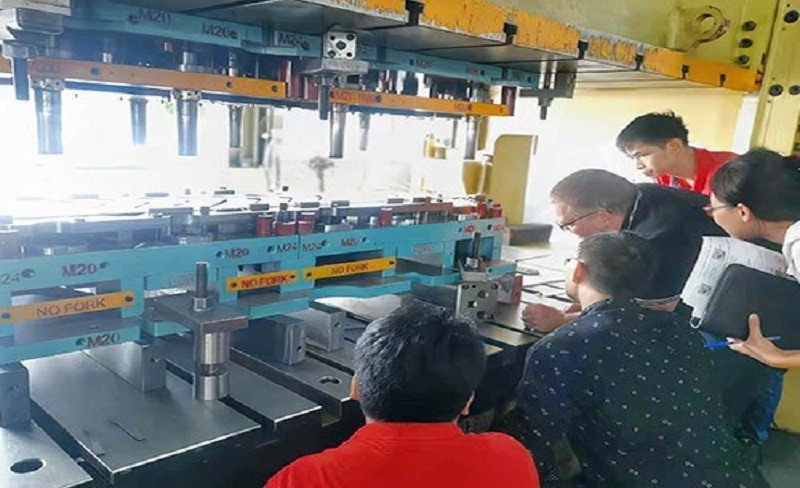


Certificate


FAQ


